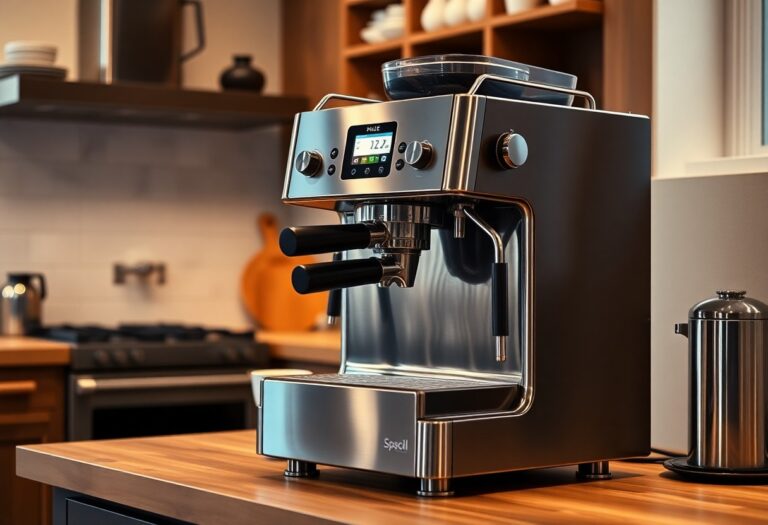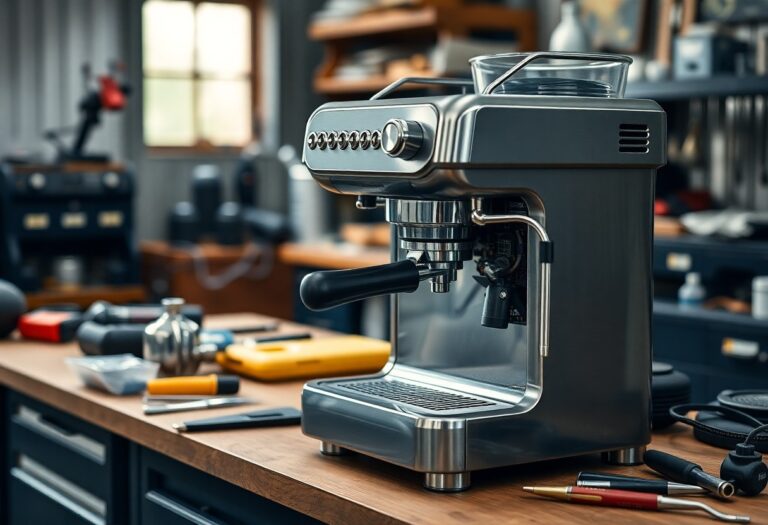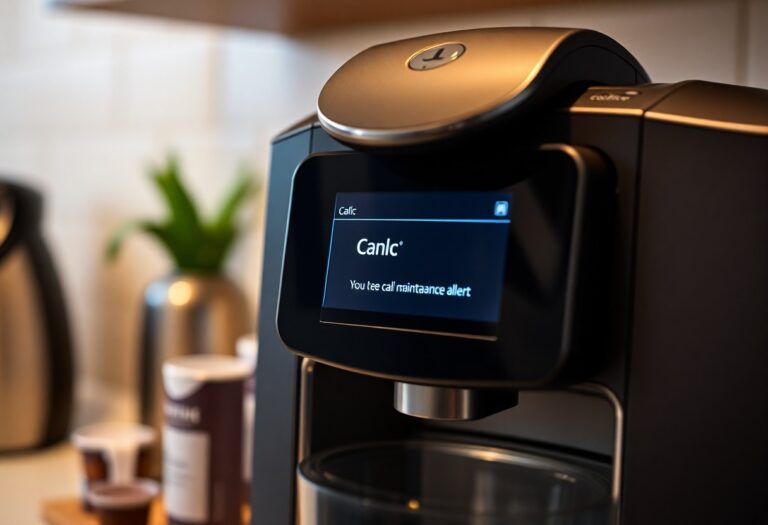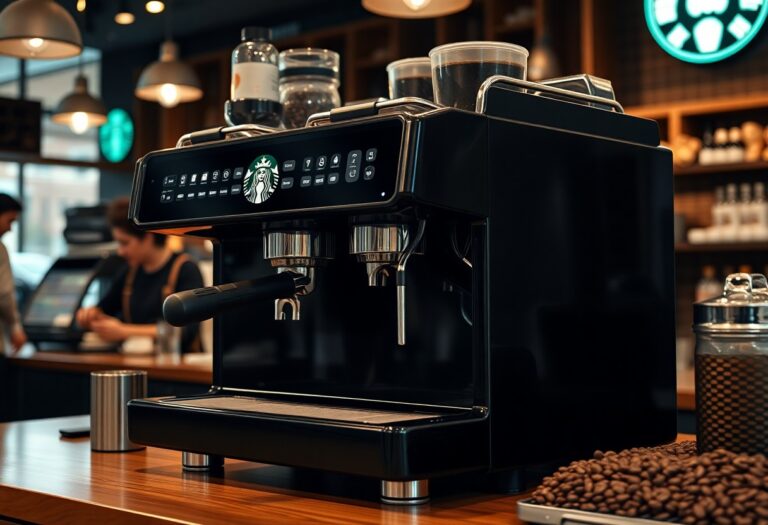What Type of Coffee Beans for Espresso Machine – Bean Categories
Beans play a vital role in crafting the perfect espresso, as not all coffee beans provide the same flavor profile and richness. You should consider bean categories like Arabica and Robusta to achieve your desired taste. Arabica beans typically offer a smoother and more aromatic profile, while Robusta beans present a stronger, more bitter flavor with higher caffeine content. Choosing the right beans can elevate your espresso experience. For deeper insights, explore Which Popular Coffee Brands Work Best For An Espresso … and refine your selection.

Key Takeaways:
- Espresso is typically made with Arabica and Robusta beans, with Arabica offering sweetness and complexity while Robusta adds a rich crema and bold flavor.
- The roast level significantly impacts espresso flavor; medium to dark roasts are preferred for their rich, bold characteristics.
- Single-origin beans can provide unique flavor profiles, while blends are often crafted for balanced taste and consistency.
- Freshness is key; using freshly roasted beans within a few weeks can enhance the quality and taste of your espresso.
- Grinding beans just before brewing is important to achieve optimal flavor extraction in your espresso machine.
The Flavor Spectrum: Understanding Bean Profiles
Exploring the flavor spectrum of coffee beans reveals the intricate profiles that define your espresso experience. Each coffee bean variety has a distinct combination of aromas, acidity, sweetness, and bitterness, which influences the final taste in your cup. Whether it’s a fruit-forward Ethiopian bean or a chocolatey Brazilian blend, understanding these flavor nuances allows you to select beans that align perfectly with your palate preferences, making your espresso moments even more enjoyable.
Arabica vs. Robusta: A Flavor Duel
In espresso, the battle between Arabica and Robusta beans often boils down to flavor preference. Arabica beans present a delicate sweetness, often exhibiting floral or fruity notes, while Robusta beans are known for their bold, earthy flavors and a touch of bitterness that can enhance crema. When choosing beans for your espresso machine, consider how these contrasting flavor profiles will complement your brewing technique and your unique taste.
The Role of Terroir in Bean Quality
The concept of terroir plays a vital role in determining the quality and flavor profile of your coffee beans. Different growing conditions, such as altitude, climate, and soil composition, contribute to the unique characteristics of coffee from specific regions. For instance, beans sourced from high-altitude farms often develop higher acidity and more complex flavors, creating a more vibrant espresso shot that elevates your overall tasting experience.
Examining the impact of terroir reveals that each coffee-growing region boasts its own signature profiles. For example, Colombian coffee is renowned for its balanced sweetness and bright acidity, while Guatemalan varieties often carry rich notes of chocolate and spice. Factors like rainfall, sunlight exposure, and soil types can significantly alter the way flavors manifest in the beans, ultimately affecting how your espresso tastes. Sourcing beans from well-established regions can enhance the flavor journey in your cup, allowing for deeper appreciation of the intricate storytelling behind each sip of espresso.
Appreciate the Roast: How Roasting Impacts Espresso
Roasting transforms green coffee beans into the aromatic, rich beans that you recognize. This process not only develops flavors and aromas but also influences the caffeine content and acidity of your espresso. The length and temperature of the roast play pivotal roles; lighter roasts tend to be brighter and retain more acidity, while darker roasts yield a bolder, fuller body and reduced acidity. Exploring various roasts can enhance your espresso experience, allowing you to uncover your personal preferences.
Medium vs. Dark Roast: Finding Your Perfect Balance
A medium roast strikes a balance between the sweet, fruity notes of a light roast and the deep, earthy flavors found in dark roasts. This variety offers a harmonious flavor profile that many espresso enthusiasts enjoy. Dark roasts, however, cater to those who prefer bold, rich flavors with lower acidity. By experimenting with both, you can identify which roast resonates with your palate, ensuring your espresso is a true delight.
The Science of Roast Levels and Extraction
Understanding the science behind roast levels and extraction is vital for crafting outstanding espresso. During the roasting process, the Maillard reaction and caramelization bring out various flavor compounds. A lighter roast often requires a finer grind and longer extraction time to draw out its complex flavors, while a darker roast benefits from coarser grounds and quicker extractions to avoid bitterness, leading to different flavor outcomes in your cup.
This interplay between roast level and extraction is fascinating. Lighter roasted beans can express bright acidity and fruity notes, but if extracted too long, these flavors may turn sour. Conversely, darker roasts with their deep, robust flavors can become overly bitter if the brew time is too short. The ideal extraction time for espresso typically hovers around 25 to 30 seconds, but this can vary based on the roast level used. Understanding these dynamics lets you fine-tune your brewing technique for optimal results with every shot, allowing you to experience the full spectrum of flavors in your espresso.
Decoding Bean Freshness: Why Age Matters
Bean freshness is integral to achieving the perfect espresso shot. Freshly roasted coffee beans contain maximum aroma and flavor compounds, which diminish over time due to oxidation. Ideally, you should purchase beans roasted within the last two weeks to ensure you’re harnessing their full potential. As time passes, the vibrant notes you cherish fade, leaving behind a dull and lifeless brew that fails to deliver the desired experience.
The Detrimental Effects of Staleness
Stale beans produce flat, uninspiring coffee because the important oils responsible for flavor have evaporated. A stale espresso is often marked by a lack of body and a reduction in sweetness, making it nearly impossible for you to enjoy the nuanced flavors intended by the roaster. The result? An underwhelming cup that fails to inspire and may even leave a bitter aftertaste.
How to Source Fresh Beans
Sourcing fresh beans requires diligence in selecting the right suppliers. Look for local roasters who prioritize freshness and clearly label roast dates. Specialty coffee shops often offer freshly roasted beans, while online retailers provide the option to subscribe for regular deliveries. Engage with the coffee community to discover promotions or seasonal releases that enhance your espresso experience.
Building a relationship with your local coffee roaster can also lead to exclusive insights about their roasting schedule and upcoming batches. Many roasters will allow you to taste new arrivals before purchasing, ensuring you get to experience the latest flavors as they’re intended. Additionally, consider asking about their sourcing practices to guarantee the quality and freshness of your beans, which can significantly impact the taste of your espresso.
Beyond the Bean: The Importance of Blend Versus Single Origin
Your choice between blend and single origin beans can significantly influence your espresso experience. Blends are crafted by combining beans from various regions to achieve a harmonious and consistent flavor profile, while single origin beans celebrate the unique characteristics of a single location. This decision impacts the complexity, flavor depth, and even the body of your espresso, leading to a personal preference that best suits your palate.
The Art of Coffee Blending
Coffee blending is a craft that involves skillfully combining beans from different origins to create a well-rounded and unique flavor profile. Roasters often select beans based on flavor attributes, acidity, body, and aroma, resulting in a balanced cup that highlights the strengths of each bean. You may find blends designed specifically for espresso that enhance sweetness and complexity, delivering a smooth drinking experience.
Benefits of Single Origin Espresso
Opting for single origin espresso allows you to explore the unique flavors and aromas that specific regions impart. These beans showcase distinctive tasting notes influenced by the local growing conditions, elevation, and processing methods, providing a taste of the region’s terroir. This variety offers a richer, more educational tasting journey, as you can identify and appreciate the nuances of different coffee-growing areas.
When you choose single origin espresso, you’re not just enjoying a cup of coffee; you’re tasting the story behind it. For instance, a Guatemalan bean might reveal notes of chocolate and citrus due to its volcanic soil and climate, while an Ethiopian bean could offer vibrant floral and berry characteristics. This journey through diverse flavor profiles teaches you about the regions and practices that shape these coffees, enhancing your appreciation for the craft. Furthermore, single origin coffees are often sourced from smaller farms, allowing you to support sustainable practices and fair trade initiatives, making your coffee experience both flavorful and ethically rewarding.

Science Meets Art: The Brewing Variables that Affect Flavor
Brewing espresso is as much an art as it is a science, where precise variables converge to create the ultimate flavor profile. Factors such as grind size, water temperature, and pressure play pivotal roles in achieving that perfect shot. For deeper insights into optimizing these elements, check out 7 Tips For Picking The Best Coffee Beans For Espresso.
Grind Size, Water Temperature, and Pressure
Each brewing variable influences espresso extraction and ultimately impacts the flavor. Here’s a breakdown of how these parameters interact:
| Grind Size | Finer grinds yield more intense flavors, while coarser grinds may result in a lighter profile. |
| Water Temperature | Optimal brewing temperature ranges from 195°F to 205°F; too hot can scald, while too cold under-extracts. |
| Pressure | Typically, 9 bars of pressure is ideal for extraction, promoting creamy texture and robust flavor. |
The Relationship Between Bean Type and Extraction Techniques
Different types of coffee beans react variably to extraction methods, impacting flavor and aroma. Arabica beans, with their delicate profile, benefit from precise extraction techniques that highlight their sweetness and complexity. In contrast, Robusta beans, being more bitter and earthy, may hold up to varied methods without losing their robust flavors. Understanding these relationships allows you to tailor your approach based on your choice of beans. This tailoring not only enhances your espresso experience but also ensures you get the most out of each type. Experimenting with various beans and techniques will reveal unique flavor profiles that showcase the beauty of each bean’s origin.
Summing up
Summing up, the type of coffee beans you choose for your espresso machine can significantly impact your brewing experience and flavor profile. You should consider using Arabica beans for a smooth, complex taste, while Robusta beans can add a bold and rich character with a higher caffeine content. Blends that incorporate both types can provide a well-rounded cup. Ultimately, experimenting with different bean categories will help you find the perfect match for your palate and elevate your espresso-making skills.
Q: What are the main categories of coffee beans used for espresso?
A: The two primary categories of coffee beans typically used for espresso are Arabica and Robusta. Arabica beans are known for their smooth, sweet flavor and complex aroma, making them a popular choice for espresso blends. Robusta beans, on the other hand, have a stronger, more bitter taste and higher caffeine content, which can create a crema that is fuller and thicker. Many espresso blends use a combination of both to achieve a balanced flavor profile.
Q: How does the roast level of coffee beans affect espresso quality?
A: The roast level of coffee beans significantly impacts the flavor, aroma, and overall quality of espresso. Lightly roasted beans tend to retain more acidity and fruity flavors, which can lead to a bright and lively espresso. Medium roasts strike a balance between acidity and body, offering a well-rounded flavor. Dark roasts, while rich and bold, can sometimes produce a smoky or bitter taste, which might not appeal to everyone. It’s vital to choose a roast level that aligns with personal taste preferences.
Q: Are single-origin coffee beans suitable for espresso?
A: Yes, single-origin coffee beans can be used for espresso. These beans come from a specific region or farm, offering distinct flavor notes and characteristics unique to that locale. While single-origin beans can create an interesting and vibrant espresso shot, many espresso lovers prefer blends since they balance flavors and enhance body. It ultimately depends on individual taste, as some espresso aficionados enjoy the unique profiles that single-origin coffees provide.
Q: What role does the coffee bean grind size play in espresso brewing?
A: The grind size of coffee beans is critical for espresso brewing, as it affects extraction. For espresso, a fine grind is generally recommended, as it allows for optimal water flow and extraction during the brewing process. If the grind is too coarse, the water will flow through too quickly, resulting in under-extraction and a weak flavor. Conversely, if the grind is too fine, the water may take too long to pass through, leading to over-extraction, which can produce bitter flavors. Finding the right grind size is vital for achieving the perfect espresso shot.
Q: Should I consider freshness when selecting coffee beans for espresso?
A: Yes, freshness is an important factor when selecting coffee beans for espresso. Freshly roasted beans retain their vital oils and flavor compounds, which contribute to a more vibrant and aromatic espresso. Ideally, coffee beans should be used within a few weeks of roasting for optimal taste. It’s advisable to store the beans in an airtight container away from light and heat to maintain their freshness. Investing in quality, fresh beans can significantly enhance the espresso experience.







